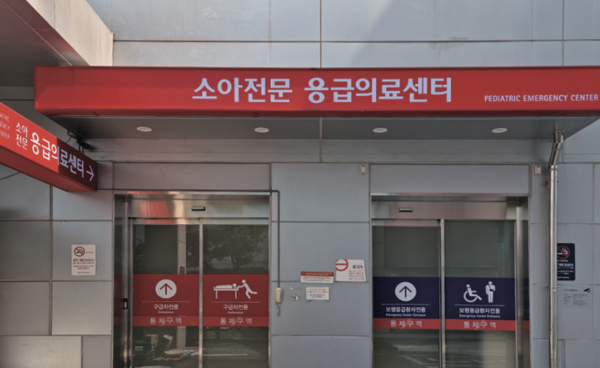Last June, a pediatric clinic was closed due to false and malicious complaints from clients. This incident highlights the challenges faced by pediatricians as the number of pediatric medical centers continues to decrease. Therefore, the Sungkyun Times (SKT) aims to investigate the current status and underlying factors of the breakdown of the Pediatric Emergency Medical system, as well as propose effective solutions to address the issue.
Destruction of the Pediatric Emergency Medical System
-What Is the Pediatric Emergency Medical System?
The Pediatric Emergency Medical System (PEMS) is a specialized healthcare network designed to provide immediate medical care to children during emergencies. The Ministry of Health and Welfare (MOHW) has been supporting Pediatric Emergency Centers (PEC) since 2016, considering the unique nature of pediatric emergency care in terms of physiology, anatomy, and pathology. The PEMS is structured as a three-level system, including primary, secondary, and tertiary care institutions. In primary care, pediatricians are responsible for providing minor treatments and prescriptions for patients with mild symptoms. Additionally, they evaluate the severity of patients’ symptoms and undertake measures, such as transferring patients to secondary and tertiary emergency medical institutions. Secondary medical institutions conduct medical procedures for hospitalized patients, and tertiary medical centers accommodate and treat critically ill patients or those who are difficult to treat in primary and secondary medical facilities. Currently, 10 pediatric specialized emergency medical centers are operating nationwide, including Seoul National University Hospital and the CHA University Bundang Pediatric Emergency Center. These centers have pediatric emergency physicians who provide specialized medical care for young patients and separate pediatric emergency rooms that differ from general emergency rooms. These rooms are also equipped with medical devices for children.
-The Current Situation of the Destruction
Currently, the PEMS is suffering from a severe shortage of human resources. According to the Korean Society of Pediatrics, the recruitment rate in pediatrics in the first half of 2023 recorded the lowest-ever figure of 15.9%. Park Ji-hyung (Freshman, College of Medicine) told the SKT, “My fellow medical students and I feel hesitant to pursue pediatric medicine because of the difficult treatments, heavy workload, and lack of compensation.” Moreover, the Korea Children’s Hospital Association (KCHA) revealed that more than 70% of children’s hospitals are contemplating the shutdown of medical operations during the night and holiday sessions due to insufficient qualified professionals. Vice President of KCHA, Kang Eun-sik, explained, “This situation will lead to delays in Pediatric Emergency Centers due to overflowing and will potentially damage the quality of medical services provided to children,” at the press conference for the normalization of PEMS. In short, the current state of PEMS in Korea is facing substantial challenges.

The Reason for Devastation
-The Decline in Pediatricians
The two main reasons for the decline in pediatricians are low profitability and emotional stress. The insufficient payments for pediatricians make it financially challenging to sustain their jobs, which leads to fewer professionals entering the field. The average medical fees per person in the pediatric department, ₩17,000, have barely changed for 30 years, which is also the lowest among the medical disciplines. During a press conference last March, the Korean Pediatric Society revealed, “Over the past 10 years, pediatricians’ incomes have decreased by 25%.” Furthermore, there has been little advancement in supporting adequate treatment for pediatricians. To ensure sufficient care at PECs, children should be accompanied by their parents or relatives. Due to scarce beds in emergency medical centers, there is no choice but to redirect non-urgent patients to primary care institutions or to refuse unnecessary treatments and examinations. In this process, some guardians resort to harsh verbal abuse, complaints, threats, and even lawsuits against medical professionals. Such problems heighten the stress on healthcare providers, hindering their ability to deliver optimal care. Last year, there was an event where parents claimed compensation of ₩20 million against a pediatrician after their child bled for cleaning earwax.

-Systematic Prodblems of Pediatrics
The current PEMS is facing an overcrowding problem. To alleviate overcrowding in emergency rooms, Moonlight Children’s Hospital offered outpatient services during late hours and holidays. Hence, last February, the MOHW proposed to announce Moonlight Children’s Hospital as one of the biggest improvement measures to establish an effective PEMS. However, Moonlight Children’s Hospitals had to either shorten operating hours or temporarily shut down. This was because of the lack of medical staff for the night and holiday shifts and insufficient budgets needed for operating the hospital. Thus, this created congested emergency wards, causing patients with severe cases to miss their golden time or timely treatment opportunities. Moreover, since there are no restrictions in using emergency medical services, patients can readily access emergency rooms without barriers whenever they claim it as an emergency. Consequently, there are no proper thresholds for utilizing emergency rooms. Originally, PECs were established to serve critically ill pediatric patients; however, without classifying severe and mild cases under the system, PECs face difficulties fulfilling their intended functions. Likewise, the structural problem of the PEMS is severe.
A Healthy Society for Children
-Securing Enough Human Resources
Adequate compensation and improvement of working conditions would increase the number of pediatricians. Given that children patients require more time and effort for care than adults, financial support for pediatricians is essential. In the case of Japan, the government applies additional medical charges for pediatric patients by up to five times compared to the regular cost of adult patients. In particular, with support from the government, it is imperative to ensure that the increased medical expenses do not lead to additional financial burdens on individual patients. Furthermore, reorganizing the complaint system is necessary to prevent malicious and false complaints from guardians. Regulating excessive demands of guardians when filing complaints or lawsuits would help doctors to avoid unnecessary work-related stress. These measures can establish a public mechanism to protect pediatric physicians who face significant burdens in legal proceedings.
-The Establishment of an Organized PEMS
It is essential to reorganize PEMS by allocating responsibilities to hospitals of different levels to ease the overflowing problem in PECs. Furthermore, PEMS could be enhanced by coordination between primary clinics, such as Moonlight Children’s Hospitals, secondary medical institutions, and specialized tertiary emergency centers. In particular, Moonlight Children’s Hospitals have to handle night and holiday non-urgent patients. Therefore, a review system must be established to assess whether patients are allocated to appropriate clinics. In addition, the approach to utilizing emergency rooms needs to be improved. According to Dong-A Ilbo, Woo Bong-sik, the Director of the Medical Policy Research Institute, stated, “Japan has been complementing its emergency medical service by establishing a comprehensive patient transfer and post-treatment system. Therefore, they could provide medical care to patients without missing any cases.” In Japan, patients cannot directly access tertiary Emergency Medical Centers; they must have a medical request form from a physician who has provided treatment at a primary or secondary emergency medical institution. To prevent excessive use of emergency rooms by non-urgent patients, Japan imposes an additional cost of approximately \70,000 when they seek treatment at the emergency rooms. The Japanese health authorities have been actively promoting and improving public awareness regarding the use of emergency rooms to minimize inconvenience for the citizens. This is because, without active cooperation from the public, the use of emergency rooms by non-urgent patients will not decrease. Korea should also restructure the system to classify patients according to severity, like Japan, allowing prompt treatment. Additionally, efforts should be made to improve public awareness regarding using emergency rooms.

Children are the most precious and vulnerable members of society, deserving the utmost protection. However, there is a shortage of specialists dedicated to their care, and the current inadequacy of the PEMS can lead to worsening symptoms and even fatalities. To address this issue, it is fundamental to improve the working conditions of pediatricians, and reorganize the system. The SKT hopes Kingos will continue to show consistent interest in creating a healthy and safe society for the children who will lead our society into the future.
